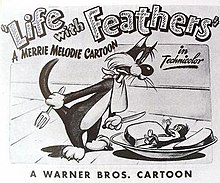Life with Feathers
| Life with Feathers | |
|---|---|
 Lobby card for Life with Feathers. | |
| Directed by | I. Freleng |
| Story by | Tedd Pierce[1] |
| Produced by | Edward Selzer (unc.) |
| Starring |
|
| Edited by | Treg Brown (unc.) |
| Music by | Carl W. Stalling Milt Franklyn (unc.) |
| Animation by |
|
| Layouts by |
|
| Backgrounds by | Paul Julian (unc.) |
| Distributed by |
|
Release date |
|
Running time | 7:41 |
| Country | United States |
| Language | English |
Life with Feathers is a 1945 Warner Bros. Merrie Melodies animated short film directed by Friz Freleng.[4] The short was released on March 24, 1945, and was the first cartoon to feature Sylvester the Cat.[5]
The title is a play on the longest-running non-musical play on Broadway, Life with Father (the title being the only connection between the two works). Warner Bros. would produce a film version in 1947.
Plot[]
An unnamed lovebird decides to commit suicide after his wife Sweetypuss kicks him out of their nest and gets a cat named Sylvester to eat him, but he thinks the bird is poisonous and refuses to eat him. For the rest of the cartoon, the lovebird attempts to get Sylvester to eat him many times. The cartoon ends with the lovebird getting a telegram saying Sweetypuss is moving out, so he escapes from Sylvester in order to keep himself from being eaten. When he gets home, he finds out she has decided to stay, and he starts looking for the Sylvester again in order to get himself eaten.
Cast[]
- Mel Blanc as Sylvester the Cat, Lovebird, Telegram Guy
- Sara Berner as Sweetypuss, Housewife
- Dave Barry as Radio Announcer
Home media[]
- VHS – Cartoon Moviestars: Tweety and Sylvester
- LaserDisc – The Golden Age of Looney Tunes, Volume 1, Side 2: Firsts.
- VHS – The Golden Age of Looney Tunes, Vol. 2: Firsts
- Blu-Ray, DVD – Looney Tunes Platinum Collection: Volume 3, Disc 2.
Notes[]
- Life with Feathers featured the first appearance of Sylvester. Sylvester would appear in 102 more shorts in the Golden Age.
- Life with Feathers was nominated for the Academy Award for Best Animated Short Film.
- This cartoon was re-released into the Blue Ribbon Merrie Melodies program on March 3, 1951. Like most reissued Merrie Melodies at the time, the original closing bullet titles were kept.
- This was the last cartoon to use the 1941–1945 opening rendition of Merrily We Roll Along and the last non-Bugs Bunny cartoon to have "WARNER BROS. PICTURES INC." and "Present" fade in after the WB shield zooms in. As such, the opening themes would be shortened, but the ending rendition still remained unchanged for another ten years.
- In 1951, Chuck Jones reused a similar concept for Hubie & Bertie's final cartoon Cheese Chasers.
- In the American and European Turner "dubbed versions" (and presumably other TV prints), Sylvester has black fur (similar to his current appearance). The restored version on Blu-Ray/DVD shows that Sylvester originally had a lighter bluish-black fur.
- The scene where Sylvester is rummaging through trash cans for food is reused in Kit For Cat, and Tweety's S.O.S. A similar but reanimated scene is also featured in Catch as Cats Can.
References[]
- ^ Beck, Jerry (1991). I Tawt I Taw a Puddy Tat: Fifty Years of Sylvester and Tweety. New York: Henry Holt and Co. p. 87. ISBN 978-0-8050-1644-4.
- ^ Ohmart, Ben (2012). Mel Blanc: The Man of a Thousand Voices. BearManor Media. p. 411. ISBN 978-1-5939-3788-1.
- ^ "Moonlighting Animation Artists in Comics: OWEN FITZGERALD -". cartoonresearch.com. January 31, 2018. Retrieved December 27, 2020.
- ^ Beck, Jerry; Friedwald, Will (1989). Looney Tunes and Merrie Melodies: A Complete Illustrated Guide to the Warner Bros. Cartoons. New York: Henry Holt and Co. p. 159. ISBN 978-0-8050-0894-4.
- ^ Lenburg, Jeff (1999). The Encyclopedia of Animated Cartoons. New York: Checkmark Books. pp. 140–142. ISBN 978-0-8160-3831-2. Retrieved June 6, 2020.
External links[]
| Wikiquote has quotations related to: Life with Feathers |
- 1945 films
- English-language films
- 1945 animated films
- Merrie Melodies short films
- Warner Bros. Cartoons animated short films
- Short films directed by Friz Freleng
- Films scored by Carl Stalling
- 1940s American animated films
- American films
- Films about suicide
- American animated short films
- Films featuring Sylvester the Cat
- Animated films about birds
- 1940s Warner Bros. animated short films
- Merrie Melodies stubs